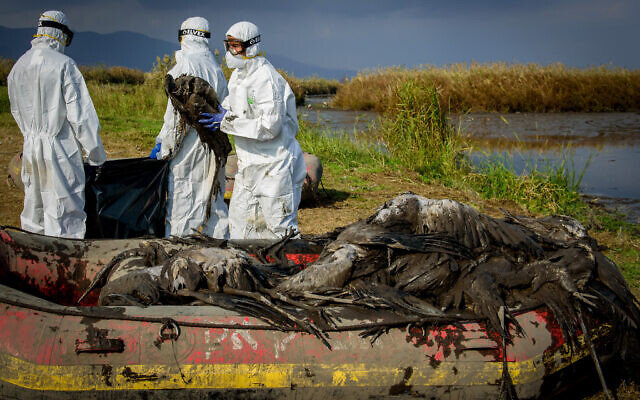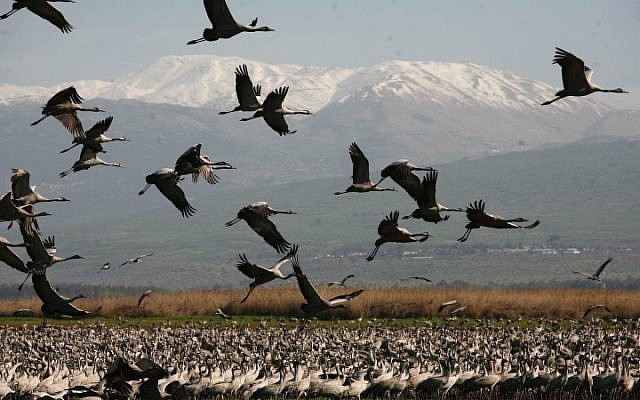The Israel Nature and Parks Authority has stopped feeding migrating pelicans in the north of Israel this year to reduce the chances of bird flu decimating concentrated flocks.
In December 2021, an outbreak of avian flu in the poultry industry spread to wild birds, a first.
Among the victims were pelicans, part of a group of some 500 that stayed in the Beit Shean area south of the Sea of Galilee. Authorities believe that feeding programs designed to keep the pelicans and other birds away from agricultural fields and fish farms wound up concentrating them in a way that made it easy for one bird infect another.
Experts note that the exact way in which bird flu spread so rapidly among wild birds is not yet fully understood.
Pelicans migrate via Israel each summer to reach wintering grounds in Africa, normally arriving in mid-August.
Get The Times of Israel's Daily Edition by email and never miss our top stories
They normally do not stay long before flying off to the Sinai Desert and continuing down the Nile to reach their winter ponds.

Agriculture Ministry staff work in protective gear to clean up dead cranes infected with Avian Influenza (bird flu) from the Hula Lake Reserve in northern Israel, January 2, 2022. (Moraz Brom/Flash90)
This year, the INPA has stopped feeding them in the Hula Valley in northern Israel, where most commercial fish ponds have closed. Pelicans that do visit the valley will still be able to look for fish, but it won’t be provided by a human hand.
The organization is continuing to provide fish in several water bodies in the Sharon area of central Israel, not only because the fish breeding industry is still substantial in the region, but because the birds will only fly onwards when their bellies are full. This is their last food station before they enter the Negev Desert.
“Between mid-August and last Friday, 26,000 pelicans entered Israel, and 22,000 left, out of a total of 50,000 that are expected,” Dolev told the Times of Israel. The rest will come through October and November.
“We’re checking them constantly, and so far, we’ve seen no dead pelicans and no evidence of bird flu,” Dolev added.
The principle for all wild birds should be to limit the artificial distribution of food as much as possible to avoid concentrating them in a particular area, he said.
Dolev refused to say if there would be any changes to the INPA feeding policy regarding cranes, saying only that the issue is more complex.
Cranes were the main victims of last year’s outbreak; an estimated one in five died from the disease, mainly in and around the Hula Lake Reserve in the Hula Valley.
Some 80,000 to 90,000 cranes pass through Israel, arriving with increasing frequency starting in October. Some 30,000 to 40,000 cranes overwinter in the country, only leaving in early to mid-March.
Several bodies are involved in discussions, including the Agriculture Ministry.

An undated photo of cranes at the Hula Lake Reserve in northern Israel. (Nati Shohat/Flash90)
Cranes take three routes, the easternmost of which stretches from Scandinavia and Russia west of the Ural Mountains, passes through Turkey and Israel, and continues on to North East Africa, Ethiopia, and Sudan.
Flanked by vast deserts to its east and the Mediterranean Sea to its west, Israel forms a key flyway and bottleneck for hundreds of millions of birds that travel between Europe, Asia and Africa every spring and fall, including perching birds (passerines), waders and birds of prey.
More than a million raptors pass through every year, including most of the world’s Levant sparrowhawks and endangered steppe eagles, and hundreds of thousands of honey buzzards and steppe buzzards.
According to the INPA’s avian ecologist Ohad Hatzofe, some 550 species have been recorded in Israel — a richness that is more characteristic of the tropics on a per-kilometer basis. Of this number, some 120 to 130 are either resident year-round or come to nest.


